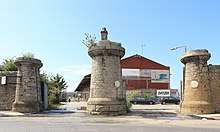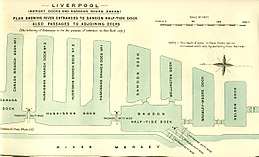Bramley-Moore Dock
Bramley-Moore Dock is a fully used dock on the River Mersey, England, and part of the Port of Liverpool. The dock is located in the northern dock system in Vauxhall, connected to Sandon Half Tide Dock to the north and Nelson Dock to the south. Jesse Hartley was the architect with opening in 1848. In December 2019 Everton F.C. applied for planning permission for a stadium to be built on the dock.The People's Project
| Bramley-Moore Dock | |
|---|---|
 Dock gates on the Dock Road | |
| Location | |
| Location | Vauxhall, Liverpool, United Kingdom |
| Coordinates | 53.4250°N 3.0030°W |
| OS grid | SJ334924 |
| Details | |
| Owner | The Peel Group[1] |
| Operator | Mersey Docks and Harbour Company |
| Opened | 4 August 1848[2] |
| Type | Wet dock |
| Joins | |
| Area | 9 acres (3.6 ha), 3,106 sq yd (2,597 m2)[3] |
| Width at entrance | 60 ft (18 m)[3] |
| Quay length | 935 yd (855 m)[4] |
 Bramley-Moore Dock Location within Merseyside |
History
The dock was opened on 4 August 1848,[2] as part of Jesse Hartley's major northern expansion scheme of that year, and was named after and opened by John Bramley-Moore, chairman of the dock committee at the time.[1][2] When built, Bramley-Moore Dock was the most northerly part of the dock system.[2] At the time, access to the River Mersey was from the south, through the new Nelson and Salisbury Docks, which were all commissioned simultaneously. When built, Bramley-Moore Dock was used for the largest steamships of the era.[5]
In 1851, further docks were opened to the north. These included Wellington Half Tide Dock, which gave a second access point for Bramley-Moore into the Mersey. The berthing of the larger ships was moved to the new Sandon Dock and Huskisson Dock within a few years of opening because of the ease of access to the river these docks offered. Around 1900, the Wellington Dock and the adjoining Sandon Dock were realigned, with the half tide dock separated as Sandon Half Tide Dock, as it remains today.
Although a mixed use dock, with one of the original transit sheds still in place, Bramley-Moore did extensive coal trade.[6] The coal handling included both coal for export and bunker coal for steamships in the port, transported from the South Lancashire Coalfield. A high-level railway opened in 1857 to transport coal directly to the north quay.[6] The high-level railway was connected by viaduct to the adjacent Lancashire and Yorkshire Railway line.[7] The high-level railway was operational from 1856 to 1966.[5]
After the decline in coal-fired steamships, the dock continued to export coal. Following the demise of coal mining in South Lancashire, and most of the UK, the export market for coal dissolved with the dock ceasing coal exports in 1988.[6] The dock is still commercially active with one of the original 1848 transit sheds still in use. Two other quays are used for unloading aggregates. The port's Svitzer tugs are based, with their home berths, in the dock.

Bramley-Moore Dock is the location of one of Liverpool's brick-built hydraulic accumulator towers.[8] The tower provided hydraulic power to dock gates and lifting equipment.

Future of the dock
In 2007, the Peel Group, owners of the Mersey Docks and Harbour Company, unveiled the £5.5 billion Liverpool Waters regeneration programme. Bramley-Moore Dock is encompassed in the 150-acre (0.61 km2) site.[9]
Bramley-Moore Dock is the most northern of the docks within the Liverpool Maritime Mercantile City World Heritage Site & the planned Liverpool Waters and the most southerly of the working docks.[10] The hydraulic tower and dock retaining walls are Grade II listed buildings.[1][11]
On 23 March 2017 it was announced that an agreement was reached between Liverpool City Council, Everton F.C. and Peel Holdings to acquire the dock for a new football stadium.[12] A planning application was submitted on 23-Dec-2019. [13]
References
- McHale, Kirsty (30 August 2016). "New Everton stadium: The story of Bramley-Moore Dock". Liverpool Echo. Retrieved 30 August 2016.
- "Bramley-Moore Dock". Liverpool History Online. Archived from the original on 16 January 2009.
- Baines 1859, Part II, p. 85
- Baines 1859, Part II, p. 116
- McCarron & Jarvis 1992, pp. 12–14
- "Trading Places - a history of Liverpool Docks". Liverpool Museums. Archived from the original on 28 October 2008.
- Ritchie-Noakes 1980, p. 50
- "Hydraulic Engine House at Bramley Moore Dock, Liverpool". British Listed Buildings. Retrieved 30 August 2016.
- "Peel unveil £5.5 billion investment plans". Peel Group. 6 March 2007. Archived from the original on 9 October 2007. Retrieved 18 April 2008.
- Bond, Stephen (28 February 2011). "Assessment of the potential impact of the proposed Liverpool Waters master plan on OUV, at Liverpool Maritime Mercantile WHS, for English Heritage" (PDF). The Architects' Journal. p. 27. Retrieved 4 September 2016.
- "Bramley Moore Dock Retaining Walls, Liverpool". British Listed Buildings. Retrieved 30 August 2016.
- "Everton agree deal for new stadium site". BBC News Online. 23 March 2017.
- "Everton submit plan for Bramley-Moore Dock stadium". BBC News Online. 23 December 2019.
Sources
- Baines, Thomas (1859). Liverpool in 1859. London: Longman & Co. OCLC 43484994.CS1 maint: ref=harv (link)
- McCarron, Ken; Jarvis, Adrian (1992). Give a Dock a Good Name?. Birkenhead: Merseyside Port Folios. ISBN 9780951612941. OCLC 27770301.CS1 maint: ref=harv (link)
- Ritchie-Noakes, Nancy (1980). Jesse Hartley: Dock Engineer to the Port of Liverpool, 1824-60. Merseyside County Museums. ISBN 9780906367056. OCLC 21118112.CS1 maint: ref=harv (link)
External links
| Wikimedia Commons has media related to Bramley-Moore Dock. |